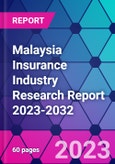During the period from 2011 to 2021, Malaysia's total and foreign currency insurance premiums exhibited steady growth, with a Compound Annual Growth Rate (CAGR) of 3.2%. Much of this growth can be attributed to the life and takaful segment, which achieved a robust CAGR of 4.5%, resulting in an increase in penetration from 3.1% in 2011 to 3.9% in 2021. Conversely, the general (non-life) insurance and takaful markets experienced more moderate growth, with a CAGR expansion of only 0.4% over the last decade.
The automobile insurance sector significantly dominates the insurance landscape in Malaysia, representing 46% of the general insurance market and nearly two-thirds of the general takaful market. Following closely are fire insurance and health/personal accident insurance. Meanwhile, the takaful market is primarily characterized by personal lines, with automobile and health insurance collectively accounting for about 20% of the total market. These two segments hold a substantial 75% share of the takaful market, compared to 57% in the general insurance segment.
Between 2017 and 2021, Malaysia's annual premium income exhibited a fluctuating trend, experiencing a minimal CAGR of 0.03%, according to the analyst. However, as the Malaysian economy gradually rebounds beyond 2022, the growth rate of premium income within the Malaysian insurance industry is expected to rise.
The analysis anticipates the Malaysian insurance market will experience growth in the future. This growth will likely be driven by heightened public awareness of insurance, the increase in disposable income among the population, and the influence of insurtech, which is making insurance services more tailored and accessible. The projection suggests that Malaysia's insurance premium income will reach $5.03 billion by 2032, growing at a Compound Annual Growth Rate (CAGR) of 3.6% from 2023 to 2032.
Topics covered:
- Overview of the Malaysian Insurance Industry
- Economic and Policy Environment of the Malaysian Insurance Industry
- What is the impact of COVID-19 on the Malaysian insurance industry?
- Malaysia Insurance Industry Market Size, 2023-2032
- Analysis of major Malaysian insurance industry players
- Key Drivers and Market Opportunities in the Malaysian Insurance Industry
- What are the key drivers, challenges and opportunities for the insurance industry in Malaysia during the forecast period 2023-2032?
- Which are the key players in the Malaysia insurance industry market and what are their competitive advantages?
- What is the expected revenue of Malaysia insurance industry market during the forecast period of 2023-2032?
- What strategies have been adopted by the key players in the market to increase their market share in the industry?
- Which segment of the Malaysia insurance industry market is expected to dominate the market by 2032?
- What are the major unfavorable factors facing the insurance industry in Malaysia?
Table of Contents
Companies Mentioned
ALLIANZ- TAKAFUL
- MANULFE
- MAA
- MNRB
- TUNEPRO
- MPHBCAP
- LPI
Methodology
Background research defines the range of products and industries, which proposes the key points of the research. Proper classification will help clients understand the industry and products in the report.
Secondhand material research is a necessary way to push the project into fast progress. The analyst always chooses the data source carefully. Most secondhand data they quote is sourced from an authority in a specific industry or public data source from governments, industrial associations, etc. For some new or niche fields, they also "double-check" data sources and logics before they show them to clients.
Primary research is the key to solve questions, which largely influence the research outputs. The analyst may use methods like mathematics, logical reasoning, scenario thinking, to confirm key data and make the data credible.
The data model is an important analysis method. Calculating through data models with different factors weights can guarantee the outputs objective.
The analyst optimizes the following methods and steps in executing research projects and also forms many special information gathering and processing methods.
1. Analyze the life cycle of the industry to understand the development phase and space.
2. Grasp the key indexes evaluating the market to position clients in the market and formulate development plans
3. Economic, political, social and cultural factors
4. Competitors like a mirror that reflects the overall market and also market differences.
5. Inside and outside the industry, upstream and downstream of the industry chain, show inner competitions
6. Proper estimation of the future is good guidance for strategic planning.

LOADING...
Table Information
| Report Attribute | Details |
|---|---|
| No. of Pages | 60 |
| Published | September 2023 |
| Forecast Period | 2023 - 2032 |
| Estimated Market Value ( USD | $ 3.66 Billion |
| Forecasted Market Value ( USD | $ 5.03 Billion |
| Compound Annual Growth Rate | 3.5% |
| Regions Covered | Malaysia |
| No. of Companies Mentioned | 8 |









